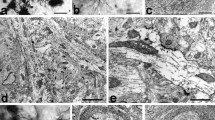Summary
The massa caudalis of the subcommissural organ-Reissner's fiber complex of lamprey larvae (Geotria australis) was studied immunocytochemically at the ultrastructural level by use of the immunoperoxidase-silver methenamine procedure. An antiserum raised against bovine Reissner's fiber was utilized as primary antibody.
The caudalmost portion of the central canal and its ampulla caudalis communicate, via wide intercellular spaces in their dorsal wall, with large cavities or lacunae. In addition, distinct openings in the dorsal wall of the ampulla establish an open communication between the latter and the lacunae. The lacunae are lined by slender processes of cells of unknown nature. No junctional complexes can be observed between these cells, which lack a basal lamina. The lacunae communicate with structures resembling blood capillaries, however, they are devoid of a basal lamina. These peculiar vessels, in turn, are in direct communication with characteristic blood capillaries.
Reissner's fiber (RF) and its massa caudalis are strongly immunoreactive with the antiserum used. The wide intercellular spaces in the dorsal wall of the central canal and the ampulla, as well as the lumina of the (i) lacunae, (ii) modified vessels and (iii) blood capillaries are filled with a flocculent, strongly immunoreactive material. No immunoreactive material was found outside these structures. Thus, the blood capillaries appear to represent the only final target of RF-material arriving at the ampulla caudalis.
Similar content being viewed by others
References
Ermisch H (1973) Zur Charakterisierung des Komplexes Subcommissuralorgan-Reissnerscher Faden und seiner Beziehung zum Liquor unter besonderer Berücksichtigung autoradiographischer Untersuchungen sowie funktioneller Aspekte. Wiss Z Karl-Marx-Univ Leipzig Math Naturwiss Reihe 22:297–336
Hofer H (1963) Neuere Ergebnisse zur Kenntnis des Subkommissuralorganes, des Reissnerschen Fadens und der Massa caudalis. Verh d Zool Ges 431–440
Hofer H, Meinel W, Erhardt H, Wolter A (1984) Preliminary electron-microscopical observations on the ampulla caudalis and the discharge of the material of Reissner's fibre into the capillary system of the terminal part of the tail of ammocoetes (Agnathi). Gegenbaurs Morphol Jahrb Leipzig 130, 1:77–110
Leonhardt H (1980) Organum subcommissurale: In Oksche A (ed) Handbuch der Mikroskopischen Anatomie des Menschen 4 Band: Nervensystem, 10. Teil: Neuroglia I. Springer, Heidelberg Berlin New York, pp 472–504
Naumann W (1968) Histochemische Untersuchungen am Subkommissuralorgan und Reissnerschen Faden von Lampetra planeri (Bloch). Z Zellforsch 87:571–591
Oksche A (1969) The subcommissural organ. J Neurol Visc Relat [Suppl] 9:111–139
Olsson R (1955) Structure and development of Reissner's fibre in the caudal end of amphioxus and some lower vertebrates. Acta Zool (Stockholm) 36:167–198
Olsson R (1958) Studies on the subcommissural organ. Acta Zool (Stockholm) 39:71–102
Rodríguez EM, Oksche A, Hein S, Rodríguez S, Yulis R (1984a) Comparative immunocytochemical study of the subcommissural organ. Cell Tissue Res 237:427–441
Rodríguez EM, Yulis R, Peruzzo B, Alvial G, Andrade R (1984b) Standardization of various applications of methacrylate embedding and silver methenamine for light and electron microscopy immunocytochemistry. Histochemistry 81:253–263
Rodríguez EM, Herrera H, Peruzzo B, Rodríguez S, Hein S, Oksche A (1986) Light- and electron-microscopic lectin histochemistry and immunocytochemistry of the subcommissural organ: evidence for processing of the secretory material. Cell Tissue Res 243:545–559
Rodríguez S, Rodríguez P, Banse C, Rodríguez EM, Oksche A (1986) Reissner's fiber, massa caudalis and ampulla caudalis in the spinal cord of lamprey larvae (Geotria australis). Light-microscopic immunocytochemical and lectin-histochemical studies. Cell Tissue Res 247:359–366
Sterba G (1969) Morphologie und Funktion des Subcommissural-organs. In: Sterba G (Hrsg) Zirkumventrikuläre Organe und Liquor. Int Symps Schloß Reinhardsbrunn 1968. Fischer Jena S 17–32
Sterba G, Naumann W (1966) Elektronenmikroskopische Untersuchungen über den Reissnerschen Faden und die Ependymzellen im Rückenmark von Lampetra planeri (Bloch). Z Zellforsch 72:516–524
Sternberger IA, Hardy PH, Jr Cuculis JJ, Meyer HG (1970) The unlabeled antibody enzyme method of immunohistochemistry: Preparation and properties of soluble antigen-antibody complex (horseradish peroxidase-antiperoxidase) and its use in identification of spirochetes. J Histochem Cytochem 18:315–333
Studnička FK (1899) Der Reissnersche Faden aus dem Centralkanal des Rückenmarkes und sein Verhalten im Ventriculus terminalis. Sitz-Ber, K. Böhm Ges Wiss, Math-Naturwiss K1 36, 1
Wislocki GB, Leduc EH, Mitchele AJ (1956) On the ending of Reissner's fiber in the filum terminale of the spinal cord. J Comp Neurol 104:493–517
Author information
Authors and Affiliations
Additional information
Supported by Grant I 38259 from the Stiftung Volkswagenwerk, Federal Republic of Germany, Grant S-85-39 from the Dirección de Investigaciones, Universidad Austral de Chile, and Grant 6027 from Fondo Nacional de Desarrollo Científico y Tecnológico, Chile. The authors express their gratitude to Mrs. Elizabeth Santibáñez and Mr. Julio Lamilla for providing the lamprey larvae and to Mr. Humberto Molina for preparing the three-dimensional drawing
Rights and permissions
About this article
Cite this article
Peruzzo, B., Rodríguez, S., Delannoy, L. et al. Ultrastructural immunocytochemical study of the massa caudalis of the subcommissural organ-Reissner's fiber complex in lamprey larvae (Geotria australis): Evidence for a terminal vascular route of secretory material. Cell Tissue Res. 247, 367–376 (1987). https://doi.org/10.1007/BF00218318
Accepted:
Issue Date:
DOI: https://doi.org/10.1007/BF00218318




